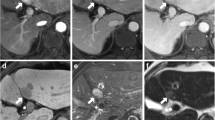Abstract
This investigation was aimed to assess the usefulness of delayed hepatobiliary imaging in the diagnosis of small hepatocellular carcinoma (HCC). Sixty-two patients with this hepatic cancer were included in the study. 56 males and 6 females, with a mean age of 50.6 yr. (32–72 years old). All patients were performed by surgery, verified histologically, and these tumors were smaller than 5cm. Liver scans were performed 5 minutes, 2 hours and 5 hours after the administration of radiopharmaceutices. In 31 of the 62 patients (50%), the tumor exhibited equal radioactivity uptake or greater radioactivity uptake than the surrounding liver in delayed imaging. And the sensitivity was 33.3% (2/6), 41.2% (7/17), 60.0% (9/15) and 54.2% (13/24) in the tumor size was ⩽2 cm, 2–3cm, 3–4 cm and 4–5 cm, respectively. The smallest mass to be detected was only 1.2 cm. The uptake of radiopharmaceutic was nonsignificantly related to serum AFP level and hepatic cirrhosis (P>0.05). These results show that99mTc-PMT delayed hepatobiliary imaging can be useful in the diagnosis of small hepatocellular carcinoma.
Similar content being viewed by others
References
1981; 342–361.
Hisada K. Clinical aspect of SPECT. First edition. Kanehara: Kanehara & Co., Ltd. 1986; 141–155.
Tang ZY. Subclinical hepatocellular carcinoma. Berlin, Heidelberg: Springer-Verlag. 1985.
Wagner HN. Nuclear medicine in the l990s: The challenge of change. J Nucl Med 1985; 26:679.
Okuda K. Early recognition of hepatocellular carcinoma. Hepatology 1986; 6:729.
Utz JA, et al. Hapatoma visualization with99mTc-pyidoxylidene glutamate. J Nucl Med 1980; 21:747.
Cannon JR, et al. Uptake of99mTc-PIPIDA in pulmonary metastases from a hepatoma. Clin Nucl Med 1980; 5:22.
Ueno K, Haseda Y. Concentration and clearance of99mTc-pyridoxyliden isoleucine by a hepatoma. Clin Nucl Med 1980; 5:196.
Yeh SH, et al. Sensitivity of99mTc-HIDA liver scintigraphy for diagnosing hepatoma. J Nucl Med 1981; 22:86.
Lee VW, Shapiro JH. Spacific diagnosis of hepatoma using99mTc-HIDA and other radionuclides. Eur J Nucl Med 1983; 8:191.
1983; 3:173.
Hasegawa Y, et al. Specific diagnosis of hepatocellular carcinoma by delayed hepatobiliary imaging. Cancer 1986; 57: 230.
Zhao HY.99mTc-PMT liver imaging—A new marker for hepatoma. New Tumor Markers and their Monoclonal Antibodies. 4th Symposium on tumrr markers, Hamburg. 1987; 458–463.
1982; 9:101.
Author information
Authors and Affiliations
Rights and permissions
About this article
Cite this article
Chen, S., Zhao, H., Yuan, A. et al. The usefulness of99Tc-PMT delayed hepatobiliary imaging in the diagnosis of small hepatocellular carcinoma. Chin J Cancer Res 4, 61–66 (1992). https://doi.org/10.1007/BF02997512
Issue Date:
DOI: https://doi.org/10.1007/BF02997512




